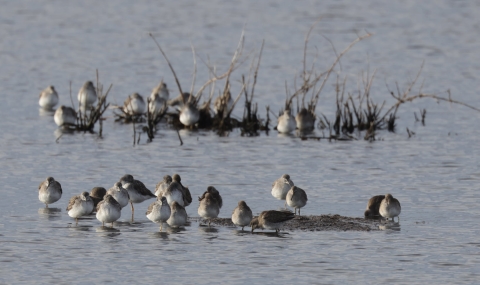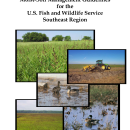The North West Pool and South West Pool impoundments are managed to provide optimal habitats for migrating and wintering shorebirds and waterfowl. Water levels can be manipulated to provide adequate water for birds to drink, preen, rest, and feed. The water levels between the two pools can be managed independently from each other. One of the primary benefits from this management is the ability to manage for moist soils. By lowering water levels to shallow depths ranging from a few inches to as little as a quarter inch, aquatic vegetation like dwarf spike rush (Eleocharis parvula) and common duckweed (Lemma minor) can germinate and grow. These are staple foods for waterfowl. Moist soils are also important for migrating shorebirds in that these soils host various species of marine invertebrates, which shorebird readily feed upon. Shallow waters also provide easy access to these food resources for the migrating birds.
At Edwin B. Forsythe NWR, we manage one of our pools for low water from early spring until early fall, while the other pool is kept at a constant water level (between 0.90 – 1.10 ft.) throughout this same period. During winter, both pools will have their water levels managed at approximately one foot in depth. Then, in the following early spring, the pool that had the constant water level management the previous year will be managed for shallow water, and vice versa. By alternating the water levels yearly with each pool, the moist soils within each pool can reach their maximum productivity for producing aquatic vegetation and aquatic invertebrates for birds.

